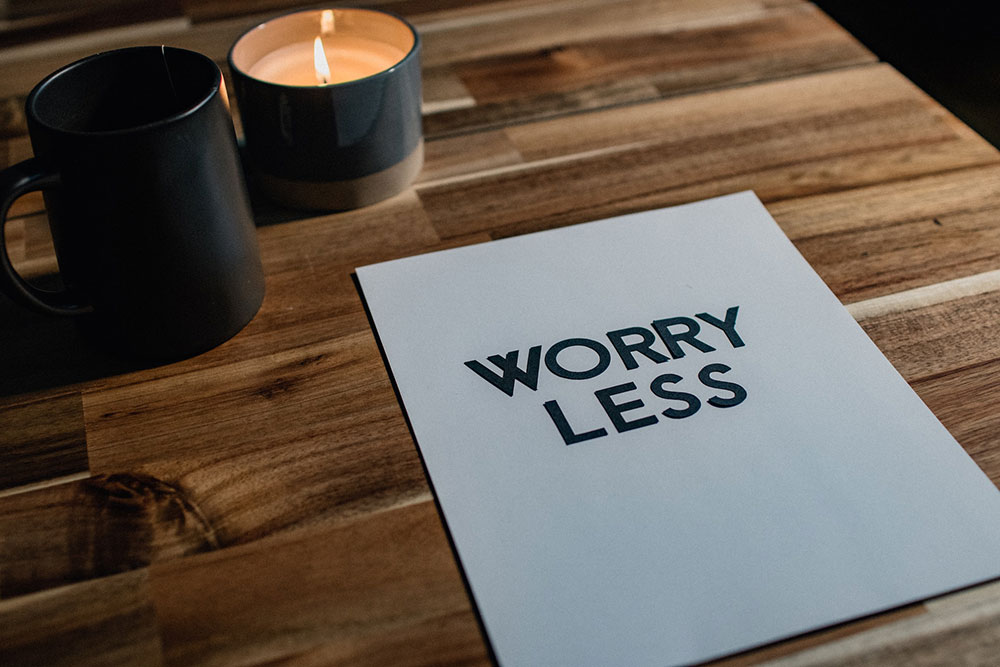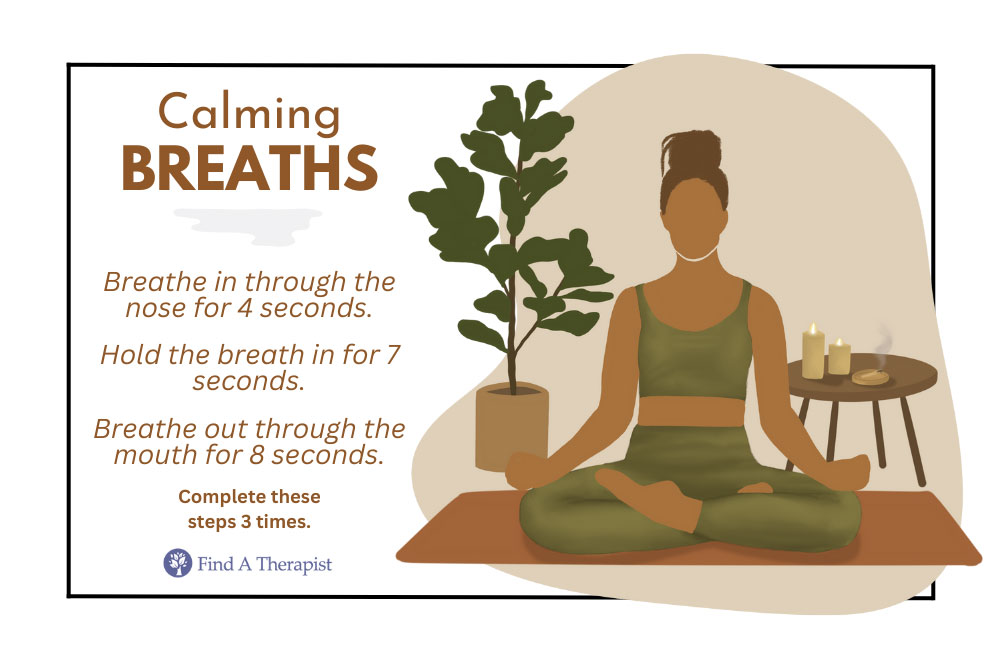How To Stop Worrying
Published on April 18th, 2023
Updated on January 29th, 2024

During uncertain times, it is natural to have worries and doubts. But when the worries feel uncontrollable or overwhelming, they can impact our daily lives, our mental health, and our overall well-being.
Worrying prevents us from seeing things clearly and making healthy decisions. It can also affect those around us, causing them to feel stressed as well. If you are experiencing excessive worry, learning ways to manage the worry can help you feel more in control instead of like your worries are controlling you.
Worry and stress can be powerful, but it is a part of life. Everyone feels stressed about different things, and worry affects each person differently. Prolonged or unmanaged worry can lead to anxiety, which affects how you cope with your day.
Sponsored by

Choose a therapist to work with and start healing with 20% off from BetterHelp.
Click HereTo manage stress, it is important to know what coping skills can help you manage your worries. They can help balance stress so it is more manageable and less intrusive. As a result, you can manage your worries and may even get to a point where you can stop worrying about what is on your mind.
With regular use of helpful coping skills, you can learn how to manage your worrying, which will help to reduce feelings of anxiety and stress. The following are helpful coping skills to help you stop your worries from impacting your life.
Manage The “What If’s”
When we worry about future events or feel uncertain about what will happen in the future, our minds tend to go to the “what if” thoughts. “What if” thoughts are anxious thoughts that cause a pattern of rumination (anxious thoughts that repeat in circles).
Ruminating about what might happen results in increased fear and anxiety. This is because the “what ifs” tend to lead to catastrophizing or thinking about the worst-case scenarios. Very rarely do we predict positive outcomes. Catching when your mind goes to the “what if” thoughts (and choosing not to follow those thoughts) is a great start to managing your worries.
Write Your Worries Down
As worries arise, it can be helpful to write them down. Once the worry is recorded, use some of the grounding techniques described in this article to bring yourself back to the present moment. Writing our worries down helps alleviate some of the “pressure” from a busy mind. It also allows you the opportunity to go back and reflect on and challenge some of the worries that you previously recorded.
Learn About Cognitive Distortions
A cognitive distortion can be found at the root of most worries. Cognitive distortions are, put simply, errors in thinking. Cognitive distortions result in thoughts that are irrational, unfounded, or just plain wrong. The following are some examples of the most common cognitive distortions:
All-Or-Nothing Thinking
All-or-nothing thinking is thinking in terms of extremes. It is an either/or way of thinking about the world that is illogical, unrealistic, and most certainly contributes to worry.
Example: Someone who struggles with all-or-nothing thinking might think, “I am a total failure” after getting a B on an exam.
A person who struggles with all-or-nothing thinking may think in terms of good or bad, right or wrong, perfect or not good enough. This leaves little room for error, growth, or imperfection, all of which are natural parts of life.
Discounting The Positive
This cognitive distortion involves minimizing positive experiences or turning positive experiences into negative ones.
Example: Someone who does well on a project might think, “Anyone could have done this well.” This way of thinking takes away from their sense of purpose and accomplishment by minimizing their effort and success.
Emotional Reasoning
This error in thinking is likely one that everyone has experienced. We fall into emotional reasoning when we take our emotions as evidence of the truth.
Example: “I feel worthless, so I am worthless”.
Mind-Reading
Mind-reading is a cognitive distortion that occurs when we assume what others are thinking and feeling. The assumptions made from mind-reading come without any supporting evidence.

Practice Mindfulness
Mindfulness is one of the most popular techniques for managing thoughts. Mindfulness is about paying attention to the present moment. We can be mindful of what is going on in the present moment both internally (physically, emotionally, and mentally) and externally (our surroundings, our behaviors, what others are saying or doing, etc.). Mindfulness helps eliminate worry, especially those “what if’s” associated with the future.
There are many ways we can increase our mindfulness:
- Checking in with and labeling our feelings
- Grounding yourself by naming the objects in the room
- Taking moments to notice and connect with sensations
- Meditating
- Breathing
The following are commonly used mindfulness practices:

Breathwork
Breathwork is an excellent form of relaxation. Consciously taking clean air into your body while focusing on your breath can be a rewarding experience. It can help relieve stress and anxiety that worries may cause. Deep breathing exercises can be helpful with relieving worries and panic and help the body feel rejuvenated and powerful.
When we are uncomfortable or stressed, our breathing tends to be shallow. This causes muscle tension and pain in different areas of our body without us even realizing it. Deep and conscious breathing helps to slow down the mind and body. It also helps to relieve muscle pain and quiet racing or uncomfortable thoughts.
Breathwork has the added benefit of being discrete. It can be performed without others noticing and does not require a private or quiet space. Because of this, deep breathing practices can be very helpful when dealing with worries in the moment. It helps calm the body and mind quickly and without resistance.
Mindful Walking
Mindful walking can be a rewarding experience when working on relaxation. Not everyone enjoys sitting still or resting as a relaxation technique, and that’s okay! An alternative to meditation, breathwork, or other stationary relaxation practices is mindful walking. Mindful walking is also simple and only involves taking a walk.
To practice mindful walking, be sure to pay attention to the sensations you experience while on your walk. Take in the smells, sights, and sounds, and try to focus on the present moment. Focus on your steps and reflect on the thoughts that come up while on your walk. Mindful walking is a great method of burning energy while decompressing from a long day.
If staying mindful while walking feels tedious, it is okay to make modifications to make the experience more enjoyable. You may consider listening to music or a podcast while walking, or enjoying a walk with a friend.
Gratitude
The link between gratitude and worries goes beyond just seeing the positive side of things. Thanks to the neuroplasticity of the brain, it can be rewired with our thoughts. The more we can focus on what we are grateful for, the more grateful thoughts our brain will produce. Over time, these thoughts of gratitude can begin to balance out the worrying thoughts. Gratitude decreases stress levels, and while stress and worry are not the same things, they are closely linked.
Note: Practicing gratitude can be simple as writing down a few things you are grateful for each day or writing gratitude letters to your loved ones.
Visualization
Visualization can help alleviate worries by calming the body and the mind. For visualization to be effective, your surroundings need to be comfortable, quiet, and without distractions. There are different visualization techniques. While each technique may be slightly different, they should all be done with eyes closed.
Note: If you struggle with visualization, try guided imagery recordings to help you focus your mind.
The exercise of visualization starts with a period of deep, slow breathing. Starting with deep breathing helps lower the respiration rate. This can essentially jump-start the relaxation process. After sufficient breathing has taken place, the breath can return to its natural rhythm, and the visualization can begin.
It is completely up to the person engaging in the visualization to determine the place they will visualize, as long as it is tranquil. Many people choose to envision themselves on the beach or in the forest.
Engaging all five senses, through imagining what the smells, sounds, etc. are can maximize relaxation. Visualization, like many relaxation techniques, becomes easier the more you do it.
Sponsored by

Find an affordable therapist online with 20% off from BetterHelp.
Click Here






Leave A Reply